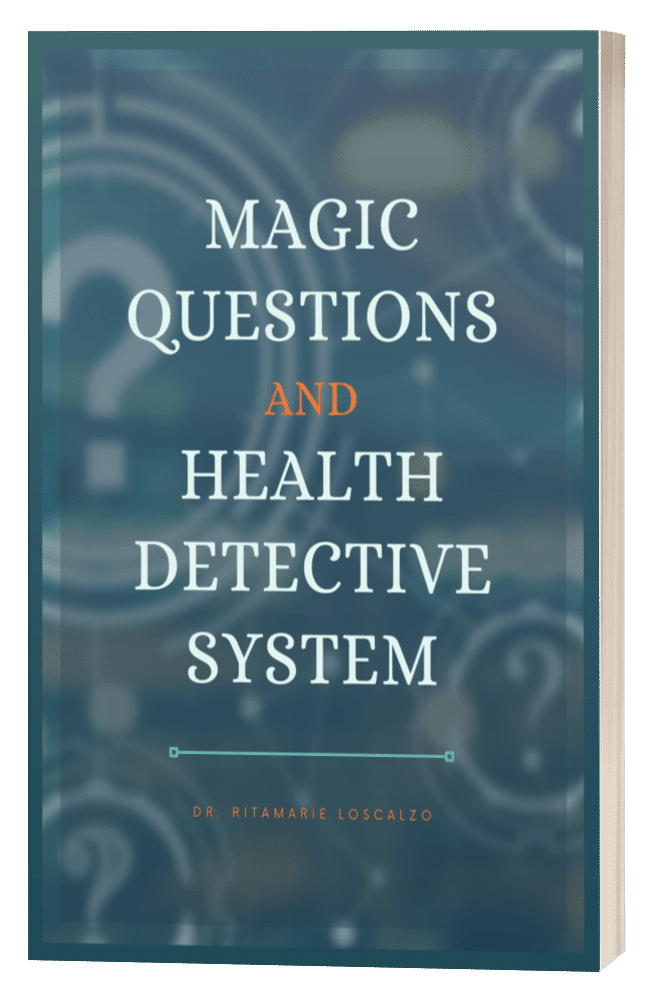HOME > blood sugar > Metabolic Syndrome – The Most Common Disease You’ve Never Heard Of?
Metabolic Syndrome – The Most Common Disease You’ve Never Heard Of?
By Ritamarie Loscalzo

Our bodies are a beautiful, complex, interwoven tapestry of systems that work collectively and cooperatively. Most importantly, none work independently. It’s impossible to influence one body system without impacting the whole.
No one understands this better than functional healthcare practitioners such as myself whose primary goal is to figure out the root cause of illness. I constantly come up against a health care system that remains focused on treating symptoms instead of preventing disease. In the meantime, people are becoming more and more sick.
Treating symptoms is like fanning at smoke without putting out the fire. I understand the smoke is important and can’t be ignored. It’s signaling there’s a problem and offers clues as to where to look. But lasting health can’t be achieved if we don’t address the source of illness.
It’s impossible to overstate the importance of your health. How you feel and how your body’s function determines how you experience life. But given the body’s complexity, when you begin the process of finding the root cause of a chronic or stubborn condition, how do you know where to start? One of the reasons I’ve focused on blood sugar for over 30 years is because you can’t go wrong. Balanced blood sugar positively serves every system in our body with no exceptions. Although I’m thrilled that its importance has finally hit mainstream medicine, blood sugar imbalance is still gravely misunderstood and undervalued as the foundation of countless conditions that plague Western societies.
A perfect example of this is Metabolic Syndrome, a new term but old illness rising to the top of medical chatter. Although the term itself entered medical textbooks relatively recently (1998), it now is estimated to impact 1 out of every 6 people in the U.S. It seems to be a condition that many people have, but no one knows much about it. In fact, it’s still being debated by experts as to whether or not it should be considered a distinct condition.
Let’s take a closer look at Metabolic Syndrome and how it is linked to blood sugar.
Metabolism & Metabolic Health
Over the years, the view of a healthy metabolism has been reduced to how quickly you can burn calories. It’s often assumed that if you don’t have a weight issue your metabolic health must be fine. But a disturbing trend is people of normal weight seem to be developing diseases typically correlated with obesity. I believe this is another direct result of unmanaged blood sugar levels.
Our metabolism is so much more than a gauge connected to a bathroom scale. To put it simply, metabolism is the chemical process by which the body’s cells change food to energy, enabling us to move, grow and reproduce-in other words-live!
This complex process is a balancing act between two opposite activities that occur simultaneously: anabolism-building tissues and storing energy, and catabolism-breaking down body tissues and energy stores to produce fuel for our bodies to work.
There are thousands of chemical processes involved in metabolism which impact every system in our body in ways science is still trying to understand. For my purposes, the broad definition of metabolic health is determined by what degree your body can successfully go through the complex dance of anabolism and catabolism with as few interruptions as possible. Based on that measurement, according to some studies, only 12% of Americans are metabolically healthy.
What Is Metabolic Syndrome?
Metabolic Syndrome is not a disease in itself, but instead a group of risk factors that increase your chances of developing diabetes, heart disease, and stroke. The factors are defined as follows:
- Increased blood pressure – 130/85 (mm Hg) or higher
- High triglyceride level – 150 (mg/dL) or 1.7 (mmol/L) or higher
- Reduced “good” HDL cholesterol – men: > 40 (mg/dL) or 1.04 (mmol/L) women: > 50 (mg/dL) or 1.3 (mmol/L)
- Large waist – men: 40 inches (102 cm), women: 35 inches (89 cm)
- Elevated fasting blood sugar – 100 (mg/dL) or 5.6 (mmol/L)
You’re considered to have Metabolic Syndrome if you have three or more of these risk factors which includes any being controlled with medication. 47 million + people are now considered to have the syndrome which doubles the chance of a person developing blood vessel and heart disease leading to heart attack and stroke. It increases the risk of type 2 diabetes by five times.
Metabolic Syndrome & Insulin Resistance
Insulin resistance and Metabolic Syndrome share many of the same traits and risks. In fact, more and more I see the two used interchangeably as if they’re the same thing, but they’re not.
There’s no debate about insulin resistance. It’s a specific condition in which cells stop responding to insulin’s message to absorb the glucose in our bloodstream and convert it to energy. When we frequently have high levels of glucose, our pancreas is constantly producing insulin. In time, our cells stop responding to the excessive insulin and become inefficient at absorbing the glucose. This causes our pancreas to produce even more insulin in an attempt to help glucose enter our cells.
This vicious cycle can lead to all the same risk factors that present as Metabolic Syndrome. The difference is we know exactly what insulin resistance is and what to do about it. By learning how to control our blood sugar, we have the power to correct or prevent insulin resistance and all the disease that comes along with it, regardless of how it’s labeled.
The Importance of Understanding Blood Sugar
As our healthcare system and mainstream media catch up with the dangers of blood sugar imbalance, more and more people are becoming aware of insulin resistance and its wide-reaching impact on our health.
Insulin resistance typically develops after years of repeated exposure to high blood sugar. The good news is, with the exception of certain genetic factors and type 1 diabetes, most of us can control blood sugar with diet and lifestyle. The challenge is that there is no one way to do it. In fact, how you do it most effectively will be directly determined by your own unique physiology.
As I mentioned earlier, our bodies are a beautiful, complex, interwoven tapestry of systems that work collectively and cooperatively. Good blood sugar balance is foundational to the health of every one of those systems. With a little work and a bit of guidance, it’s something we all can achieve.
For more than 30 years it’s been my passion to support people on that journey. I’m continuously surprised by what’s discovered as clients learn to manage their blood sugar in my Sweet Spot program. What doesn’t surprise me is the profound health improvements that take place when balance is restored.
We all deserve to experience life in the best way possible. That starts with balanced blood sugar and optimal health.
Did You Know?
This is what you need to know in order to accurately determine whether or not you have blood sugar imbalance or insulin resistance:
Blood Lab Markers:
- A1C – Indicates your average blood sugar level over a 3-month period. This is not an accurate measurement of blood sugar balance. You could be having extreme highs and lows which result in a relatively normal average reading, but the reality is your blood sugar levels are all over the place.
- Fasting Glucose – Measures the amount of glucose in your blood after a minimum 8-hour fast. It’s most often used as an indicator of possible diabetes or pre-diabetes. Although a high reading should prompt further investigation, a low reading does not guarantee your blood sugar is where it should be. Remember, it’s just a snapshot.
- Fasting Insulin – Measures your insulin levels after a minimum 8-hour fast. If you’re concerned about insulin resistance, you need to know this marker. More often than not, fasting glucose is still used to determine whether or not you have insulin resistance. The problem is you could have a normal blood sugar level, but your insulin is through the roof!
Postprandial Testing:
The best way to determine your blood sugar levels is by testing in 15-minute intervals after a meal. This way you can identify trends and see how you react to specific foods. This can be done with test strips or continuous blood glucose monitors (CGMs).
These are easy ways to identify the hidden disease of blood sugar imbalance and insulin resistance. It takes a combination of everything I’ve mentioned to truly determine whether or not you are sustaining healthy blood sugar levels. In our The Sweet Spot Solution we’ll guide you through the process of measuring and balancing your blood sugar to reduce your risk of serious complications plus achieve your ideal body weight and have more energy to enjoy your life.
In our Insulin Resistance Practitioner Training we guide health and wellness professionals to empower patients and clients to take charge of their metabolic health.
I dream of a world where metabolic wellness is the norm not the exception.
To learn more about Metabolic Imbalances, check out my Reinvent Healthcare podcast.
Share this:

Are you feeling stuck?
Do you feel as if something is missing from your practice that's keeping you from delivering breakthrough outcomes for your clients?.
Recent Posts
Our Programs
Nutritional Endocrinology Practitioner Training (NEPT)
The Mastery and Certification tier is our flagship program and provides everything you need to feel confident as a practitioner who knows how to get results that lead to healthy and happy clients.
Functional Assessment Mastery
Explore the relationships between the most important hormones and their relationship with nutrition.
Functional Nutrition Mastery
Learn how to support your clients to eat and supplement in a way that reduces and eliminates chronic symptoms.
Medical Disclaimer: The information on this website is not intended to replace a one-on-one relationship with a qualified health care professional and is not intended as medical advice. It is intended as a sharing of knowledge and information from the research and experience of Dr. Ritamarie Loscalzo, drritamarie.com, and the experts who have contributed. We encourage you to make your own health care decisions based upon your research and in partnership with a qualified health care professional.
Disclosure: Sometimes (but not always), when I share resources in my programs, newsletter, and on my website, I'm using an affiliate link, which means I do make money if you buy. My credibility is extremely important to me; therefore, I only endorse the products, services, and people I believe in. DrRitamarie.com is independently owned and the opinions expressed here are my own.
Click here to see our Privacy Policy.










